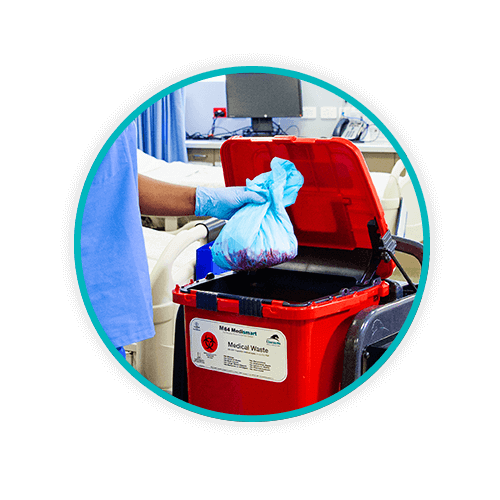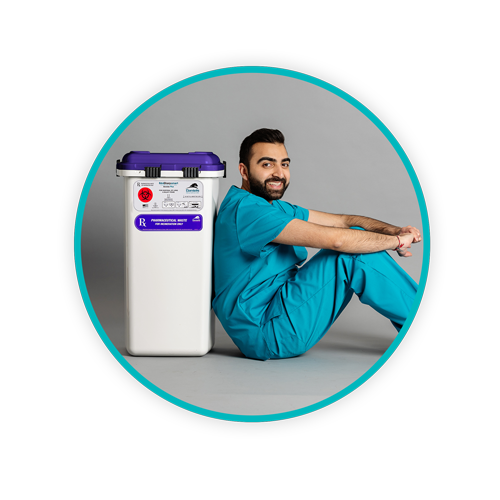5 Ways to Improve Infection Control in Hospital

All healthcare workers should be aware of standard infection prevention and control practices. Daniels Health knows that the most common and effective infection prevention protocols include but are not limited to:
- Handwashing
- Environmental hygiene
- Avoiding cross-contamination
- Vaccinations for staff of all healthcare organizations and those involved in direct patient care
- Routine infection prevention protocol assessments
- Avoiding overuse of antibiotics
- Continuity in coordination of care
However, there’s always more to do. We are dedicated to improving healthcare waste management and protocols that enhance the safety of patients, healthcare workers, ancillary staff, and public health and the environment. Additional ways to improve infection control are always front and center when developing new products and materials in regard to sanitation.
When it comes to healthcare waste management, all employees should be educated in identification of different waste stream types produced by that facility and how to handle, label (if applicable), and dispose of such waste.
Healthcare waste management training is essential as the first step toward compliant medical waste disposal. The practice also involves attention to detail when dealing with chemical waste and other waste stream management such as anatomical waste, biohazard waste, clinical waste, and infectious waste.
When applicable to healthcare waste management, infectious waste is a type of medical waste. It’s defined as any of the portion of medical waste that can possibly transmit an infectious disease.
Healthcare waste segregation is vital in improving infection control in any environment. Waste segregation relies on a healthcare worker’s ability to identify it from other types of waste. Daniels Health emphasizes that healthcare waste segregation begin at the point of origin prior to delivery of treatment or disposal.
Proper healthcare waste management not only emphasizes the importance on safety for healthcare workers, but reduces the volume of waste headed to landfills. Adequate equipment and containers distributed through healthcare structure facilitate proper and compliant segregation as well as hygiene among direct caregivers as well as ancillary staff.
Five ways to improve infection control
According to Becker’s, additional steps to improve infection control processes don’t necessarily involve direct patient care, but attention to detail when it comes to the materials, equipment, and tools used to treat patients in any healthcare environment.
As a leader in clinical infection control, Becker’s also recommends:
01 / Following manufacturer instructions when it comes to tools and equipment. This is applicable to ambulatory surgical centers, hospitals, general practices, and yes, even veterinary services and right on down to tattoo parlors. Tools and equipment have a great potential to harbor bacteria if not cleaned properly. In some cases, the initial steps for disinfecting equipment is overlooked.
02 / Ensuring that equipment – whether it’s preowned, refurbished, or has been used for a while – in your practice is in good working condition. Are all the parts working? Are any parts of the equipment or tools damaged or worn out? Have they been replaced with other parts? More importantly, are they compliant? In some cases, you may be asked to provide validation for any replacement or modified parts. All facilities should maintain direct contact with their infection control department for instructions on cleaning and maintaining medical equipment.
03 / Utilize proper disposal techniques and containers to reduce risk of cross-contamination and spreading of bacteria. For example, Daniels Health designs sharps container options that restrict hand access, reducing the risk of needlestick injury. Clinical designs and other container products developed by Daniels offer protection, are tamper-proof, shatter-proof, leak-proof, and offer hand safety/restriction. Use of proper containment systems for different waste stream segregation is essential to protect not only direct healthcare providers, but additional staff in any healthcare environment such as housekeeping, janitorial, grounds keeping staff and medical waste disposal company employees.
04 / Avoid use of outdated supplies. With tight budgets, it’s not difficult to rationalize using certain non-drug supplies. However, utilization of labels that specify the date when a package or supply has been opened can reduce the risk of contamination. The same applies to individual patient supplies. For example, Becker’s mentions an endoscopy center in Illinois that makes sure staff members use preprinted stickers with their name, the date, and time the package is opened. Such stickers are applied to any package used in day-to-day healthcare services. This ensures that some types of products like sterile water haven’t been unused and on the shelf for a longer than recommended.
05 / Whenever possible, take advantage of one-time use options such as disposable surgical gloves and needles, which are disposed after a single use. Multiple-use items must always be completely and properly sterilized (which means more than a simple cleaning, brushing, or dip into hot or soapy water) before use on another patient.
All the above measures require adequate training. Every employee within a healthcare facility should be focused on proper waste management.
How is this achieved? Some facilities utilize random monitoring practices within specific units of the hospital to ensure the proper protocols and waste segregation identification and disposal methods are compliant.
Interventions that reduce the risk of infection spread in any healthcare environment rely on awareness of the vital importance of compliant and proper healthcare waste management within all staff levels, from housekeeping, laundry and janitorial up to management.

Taking the cradle-to-grave approach
Daniels Health emphasizes the cradle-to-grave approach, which is not only the moral responsibility of healthcare waste generators, but it’s also the law. This means that the healthcare waste generators are responsible for proper waste segregation, waste stream identification, and all processes of labeling, storage, and transportation of their medical waste – from its point of origin to its final disposal by a medical waste removal company.
For more information on how Daniels Health can help your facility maintain compliant and safe healthcare waste segregation and management processes that reduce risk of infection, contact us. Our goal is to reduce container related sharps injuries, to emphasize the durability, sustainability, and cost-effectiveness of reusable containers. Most importantly, proper and compliant healthcare waste management that protects employees, public health, and the environment.
Let's Talk!
Your time is valuable, and we don’t want to play hard to get. You can either phone us directly on the details listed on our contact page, or feel free to fill out this short form and one of our team members will get back to you as quickly as possible.
